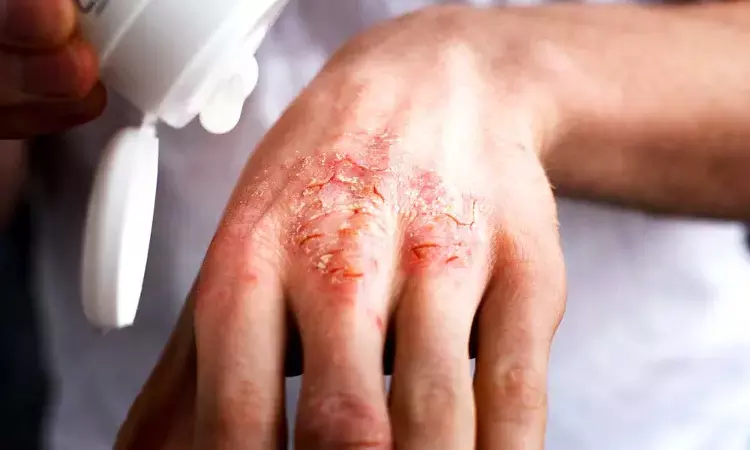- Home
- Medical news & Guidelines
- Anesthesiology
- Cardiology and CTVS
- Critical Care
- Dentistry
- Dermatology
- Diabetes and Endocrinology
- ENT
- Gastroenterology
- Medicine
- Nephrology
- Neurology
- Obstretics-Gynaecology
- Oncology
- Ophthalmology
- Orthopaedics
- Pediatrics-Neonatology
- Psychiatry
- Pulmonology
- Radiology
- Surgery
- Urology
- Laboratory Medicine
- Diet
- Nursing
- Paramedical
- Physiotherapy
- Health news
- Fact Check
- Bone Health Fact Check
- Brain Health Fact Check
- Cancer Related Fact Check
- Child Care Fact Check
- Dental and oral health fact check
- Diabetes and metabolic health fact check
- Diet and Nutrition Fact Check
- Eye and ENT Care Fact Check
- Fitness fact check
- Gut health fact check
- Heart health fact check
- Kidney health fact check
- Medical education fact check
- Men's health fact check
- Respiratory fact check
- Skin and hair care fact check
- Vaccine and Immunization fact check
- Women's health fact check
- AYUSH
- State News
- Andaman and Nicobar Islands
- Andhra Pradesh
- Arunachal Pradesh
- Assam
- Bihar
- Chandigarh
- Chattisgarh
- Dadra and Nagar Haveli
- Daman and Diu
- Delhi
- Goa
- Gujarat
- Haryana
- Himachal Pradesh
- Jammu & Kashmir
- Jharkhand
- Karnataka
- Kerala
- Ladakh
- Lakshadweep
- Madhya Pradesh
- Maharashtra
- Manipur
- Meghalaya
- Mizoram
- Nagaland
- Odisha
- Puducherry
- Punjab
- Rajasthan
- Sikkim
- Tamil Nadu
- Telangana
- Tripura
- Uttar Pradesh
- Uttrakhand
- West Bengal
- Medical Education
- Industry
Characteristic features of photoaggravated atopic dermatitis as revealed by JAMA study

UK: A case series published in JAMA Dermatology has revealed key characteristics of photoaggravated atopic dermatitis (PAD) that may contribute to better diagnosis and support the development of personalized prevention and therapy.
The study found that photoaggravated atopic dermatitis affected patients with different ages and skin prototypes (SPTs) and was linked with impaired quality of life. The researchers wrote, PAD confirmation through phototesting may provide better personalized care for patients through identifying of relevant photocontact allergies, dentification of provoking wavelengths, and appropriate photoprotection advice."
About 1.4% to 16% of patients with atopic dermatitis are said to be affected by PAD but with limited published data its characterization remains poor. Considering this, Kirsty J. Rutter, The University of Manchester, Manchester, England, and colleagues aimed to provide detailed clinical and photobiological characterization of PAD.
For the case series study, the researchers used cross-sectional data collected from 120 consecutive patients diagnosed with PAD from January 2015 to October 2019 at a tertiary center referral unit for photobiology. Descriptive statistics was used for routine collection of standardized clinical and photobiological data, and regression analysis explored associations between demographic and clinical data.
Based on the study, the researchers reported the following findings:
- Of 869 patients who underwent photoinvestigation, 120 (14%) were diagnosed with PAD (69 female [58%]; median age, 45 years; range, 5-83 years; skin phototypes [SPTs] I-VI). Of these patients, 87% were adults.
- All patients had a history of AD, and most (60%) presented with sunlight-provoked or photodistributed eczema; median age at photosensitivity onset was 37 years.
- Past-year Dermatology Life Quality Index score was greater than 10 for 80 of 103 adults (78%), and 82 of 119 (69%) had vitamin D (25-hydroxyvitamin D) level insufficiency or deficiency (<20 ng/mL; to convert ng/mL to nmol/L, multiply by 2.496).
- Broadband UV radiation provocation test results were positive for 93% of the patients.
- In 23% of patients with abnormal monochromator phototest findings, sensitivity occurred to UV-A, UV-B, and/or visible light, and UV-A of 350 ± 10 nm was the most prevalent wavelength.
- Photopatch test reactions were positive for 15% of the patients.
- Patients with SPTs V to VI (26%) vs SPTs I to IV (74%) were younger at photosensitivity onset (median age, 24 years vs 40 years), were more likely to be female (74% vs 52%]), and had a lower vitamin D status and a higher frequency of abnormal monochromator phototest findings.
To conclude, this case series study characterized the clinical and photobiological features of PAD, a poorly recognized subtype of AD
"The study's findings indicate that improved knowledge of PAD presentation, demographic aspects, and photoinvestigation can assist patient diagnosis and treatment and that more attention should be given to this condition," the researchers wrote.
Reference:
Rutter KJ, Farrar MD, Marjanovic EJ, Rhodes LE. Clinicophotobiological Characterization of Photoaggravated Atopic Dermatitis. JAMA Dermatol. Published online July 27, 2022. doi:10.1001/jamadermatol.2022.2823
Dr Kamal Kant Kohli-MBBS, DTCD- a chest specialist with more than 30 years of practice and a flair for writing clinical articles, Dr Kamal Kant Kohli joined Medical Dialogues as a Chief Editor of Medical News. Besides writing articles, as an editor, he proofreads and verifies all the medical content published on Medical Dialogues including those coming from journals, studies,medical conferences,guidelines etc. Email: drkohli@medicaldialogues.in. Contact no. 011-43720751


